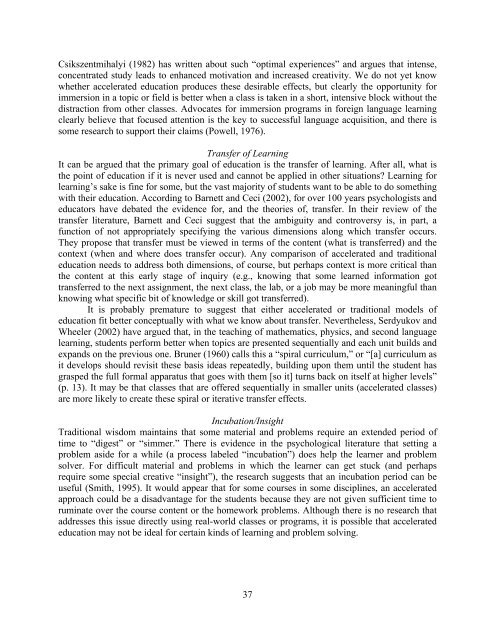Journal of Research in Innovative Teaching - National University
Journal of Research in Innovative Teaching - National University
Journal of Research in Innovative Teaching - National University
You also want an ePaper? Increase the reach of your titles
YUMPU automatically turns print PDFs into web optimized ePapers that Google loves.
Csikszentmihalyi (1982) has written about such “optimal experiences” and argues that <strong>in</strong>tense,<br />
concentrated study leads to enhanced motivation and <strong>in</strong>creased creativity. We do not yet know<br />
whether accelerated education produces these desirable effects, but clearly the opportunity for<br />
immersion <strong>in</strong> a topic or field is better when a class is taken <strong>in</strong> a short, <strong>in</strong>tensive block without the<br />
distraction from other classes. Advocates for immersion programs <strong>in</strong> foreign language learn<strong>in</strong>g<br />
clearly believe that focused attention is the key to successful language acquisition, and there is<br />
some research to support their claims (Powell, 1976).<br />
Transfer <strong>of</strong> Learn<strong>in</strong>g<br />
It can be argued that the primary goal <strong>of</strong> education is the transfer <strong>of</strong> learn<strong>in</strong>g. After all, what is<br />
the po<strong>in</strong>t <strong>of</strong> education if it is never used and cannot be applied <strong>in</strong> other situations Learn<strong>in</strong>g for<br />
learn<strong>in</strong>g’s sake is f<strong>in</strong>e for some, but the vast majority <strong>of</strong> students want to be able to do someth<strong>in</strong>g<br />
with their education. Accord<strong>in</strong>g to Barnett and Ceci (2002), for over 100 years psychologists and<br />
educators have debated the evidence for, and the theories <strong>of</strong>, transfer. In their review <strong>of</strong> the<br />
transfer literature, Barnett and Ceci suggest that the ambiguity and controversy is, <strong>in</strong> part, a<br />
function <strong>of</strong> not appropriately specify<strong>in</strong>g the various dimensions along which transfer occurs.<br />
They propose that transfer must be viewed <strong>in</strong> terms <strong>of</strong> the content (what is transferred) and the<br />
context (when and where does transfer occur). Any comparison <strong>of</strong> accelerated and traditional<br />
education needs to address both dimensions, <strong>of</strong> course, but perhaps context is more critical than<br />
the content at this early stage <strong>of</strong> <strong>in</strong>quiry (e.g., know<strong>in</strong>g that some learned <strong>in</strong>formation got<br />
transferred to the next assignment, the next class, the lab, or a job may be more mean<strong>in</strong>gful than<br />
know<strong>in</strong>g what specific bit <strong>of</strong> knowledge or skill got transferred).<br />
It is probably premature to suggest that either accelerated or traditional models <strong>of</strong><br />
education fit better conceptually with what we know about transfer. Nevertheless, Serdyukov and<br />
Wheeler (2002) have argued that, <strong>in</strong> the teach<strong>in</strong>g <strong>of</strong> mathematics, physics, and second language<br />
learn<strong>in</strong>g, students perform better when topics are presented sequentially and each unit builds and<br />
expands on the previous one. Bruner (1960) calls this a “spiral curriculum,” or “[a] curriculum as<br />
it develops should revisit these basis ideas repeatedly, build<strong>in</strong>g upon them until the student has<br />
grasped the full formal apparatus that goes with them [so it] turns back on itself at higher levels”<br />
(p. 13). It may be that classes that are <strong>of</strong>fered sequentially <strong>in</strong> smaller units (accelerated classes)<br />
are more likely to create these spiral or iterative transfer effects.<br />
Incubation/Insight<br />
Traditional wisdom ma<strong>in</strong>ta<strong>in</strong>s that some material and problems require an extended period <strong>of</strong><br />
time to “digest” or “simmer.” There is evidence <strong>in</strong> the psychological literature that sett<strong>in</strong>g a<br />
problem aside for a while (a process labeled “<strong>in</strong>cubation”) does help the learner and problem<br />
solver. For difficult material and problems <strong>in</strong> which the learner can get stuck (and perhaps<br />
require some special creative “<strong>in</strong>sight”), the research suggests that an <strong>in</strong>cubation period can be<br />
useful (Smith, 1995). It would appear that for some courses <strong>in</strong> some discipl<strong>in</strong>es, an accelerated<br />
approach could be a disadvantage for the students because they are not given sufficient time to<br />
rum<strong>in</strong>ate over the course content or the homework problems. Although there is no research that<br />
addresses this issue directly us<strong>in</strong>g real-world classes or programs, it is possible that accelerated<br />
education may not be ideal for certa<strong>in</strong> k<strong>in</strong>ds <strong>of</strong> learn<strong>in</strong>g and problem solv<strong>in</strong>g.<br />
37

















